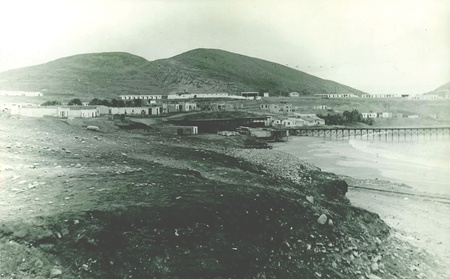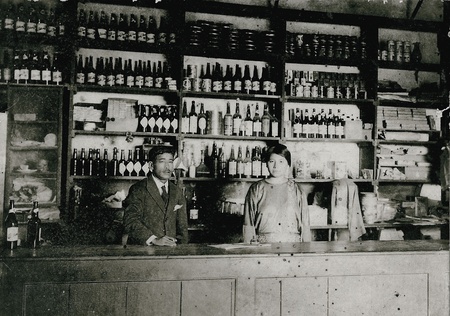At school, Daniel Saucedo Segami noticed that there were things that differentiated him from his classmates. Certain words, for example. “I once said 'bakatare' (fool) to a friend who had done something wrong. He looked at me and said 'what is that?'” Or I talked to them about butsudan and they didn't understand it.
Spurred by these differences, from a very young age Daniel became interested in his Japanese origins and, in particular, in the history of his immigrant great-grandparents who settled in the port of Chancay.

Childhood curiosity became an object of study during his youth. In 2001, thanks to an exchange between the Catholic University of Peru, where he studied archeology, and the Osaka University of Foreign Studies, he traveled to Japan for the first time.
Since then, he has had one foot in both countries. He comes and goes often. In Japan he completed postgraduate studies and acquired tools to form an interdisciplinary vision.
Studying his origins has been important, he says, to know himself better, to try to understand what part of him is Peruvian and what part is Japanese.
“My conclusion right now is that I am probably more Peruvian than Japanese, but that I can move between both environments calmly,” he says. Of course, he says that the process of getting to know each other never ends. Don't forget the adverb: now.
There are times when you realize more clearly which way the balance is leaning. Daniel reveals that the academic world in Japan is very traditional and hierarchical, which is evident when, for example, at researchers' meetings women serve tea to their male colleagues.
“That is shocking. The fact that it shocks me makes me notice that I am Peruvian.” He says that Peru is a slightly less inequitable country in terms of gender equality than Japan, that women are more empowered here. He adds that the mother is a very strong and untouchable figure in Peru, unlike in Japan.
On the other hand, there are things that bring him closer to his Japanese side. For example, making sure in a meeting that everyone has food, paying attention to the needs of others, those types of details that are also important in the Nikkei community.
On issues of identity, Daniel believes that we should not determine others, put labels on them, define them. It advocates self-determination, identity must be established by one's own perspective rather than by that of others. He also bets on elasticity: “Be flexible to connect better.”
Delving into the history of his ancestors has allowed Daniel to measure his great-grandparents' decision to migrate. He, who remembers the difficulties he had to overcome to adapt to Japan in his first stage, having internet, a plane and knowing where he was going, can hardly imagine what it must have been like to get on a boat for a trip of almost two months to a place they had no idea what it was like. “I find that attitude of adventure, that courage incredible.”

Studying your ancestors is also a way to maintain the thread between successive generations. Daniel wants to leave something for the future. If, for example, your daughter wants to know her family history when she grows up, she already has a base to work with and continue researching.
THE IMPORTANCE OF OBJECTS
Sometimes we get rid of old things that we believe are of no use. However, objects can be a valuable source of information. Many Nikkei families have belongings from their ancestors whose importance they do not always appreciate.
The objects serve to construct the history of Japanese immigration, explains Daniel. Every family story connects to the big story.
Now, he believes that a “Nikkei research center” is needed to help families. —for example— with old documents in the Japanese language that they do not understand, to save their objects if they do not have space to store them or to restore them if they are damaged.
History, he emphasizes, should not be limited only to the Nikkei, but rather it is necessary to see how it fits into the history of Peru. “It is important that we give emphasis to the Nikkei, but never stop there, always try to see how we are here, how Peru influences us and how we influence Peru.”
THE NIKKEI IN JAPAN: HAFU? GOSEI?
“The concept of Nikkei has value here. We as a community have positioned ourselves in a certain way in Peru, we are seen in a specific way. In Japan it doesn't really work. Whether you are Nikkei or not is irrelevant to many people. If you don't speak Japanese, if you don't understand the customs, you're going to be like any other person who comes to work,” says Daniel.
The children and grandchildren of the first generation of Peruvian migrants, children and young people who were born in Japan or have grown up there, “perhaps they are entering more into that idea of hafu, which is more global, than into the idea of Nikkei which is a little older. Maybe they consider themselves more like that: Japanese with something more, probably Nikkei Peruvians or Nikkei lastly. I think they are becoming more and more disconnected from that identity. Which is not bad, what happens is that it is a global phenomenon.”
Hafu comes from the English word “half” and is used to refer to children of international marriages in Japan. Although some criticize the term because it suggests a lack, as if the hafu were missing something, and prefer the word daburu (from "double" ), which denotes the idea of two cultures embracing, Daniel explains that the use of hafu It is most widespread in Japan.
Getting into the realm of definitions is difficult. The archaeologist gives the case of his own daughter as an example: “She is the daughter of a Japanese woman and a fourth-generation Nikkei woman. My daughter, what is it? Gosei or hafu ? "She's probably going to have to identify that in due course."
Beyond Japan, Daniel affirms that the term Nikkei is reaching a global dimension. “In my parents' time, talking about Nikkei was very specifically about a Lima universe, a little more than provinces at most, but thinking on a global level was strange. Now it is very easy for a Nikkei from here to communicate with one from Argentina, from the United States, to live together in similar spaces. The term Nikkei is going to change radically.”
AN EASY COUNTRY TO LIVE
Today's Japan has much more access to foreign things than the Japan that the archaeologist met on his first trip in 2001. However, perhaps to talk about greater openness is going too far. “Opening up is a more complicated term,” he says.
The Japanese like to observe what happens abroad, they can take things from abroad to create something new or improve what they have, but that does not imply that they “change their essence. They tend to be very closed on that side still.”
In addition to order, and he has noticed this particularly in the academic field, the perseverance of the Japanese stands out, the determination with which they undertake a task. “Japan teaches you to be constant.”
Daniel says that Japan is an “easy country to live in if you know the language, there are no problems.” But as a global citizen who feels comfortable living here and there, he always comes back to Peru.
* This article is published thanks to the agreement between the Peruvian Japanese Association (APJ) and the Discover Nikkei Project. Article originally published in Kaikan magazine No. 110, and adapted for Discover Nikkei.
©2017 Texto y fotos: Asociación Peruano Japonesa









